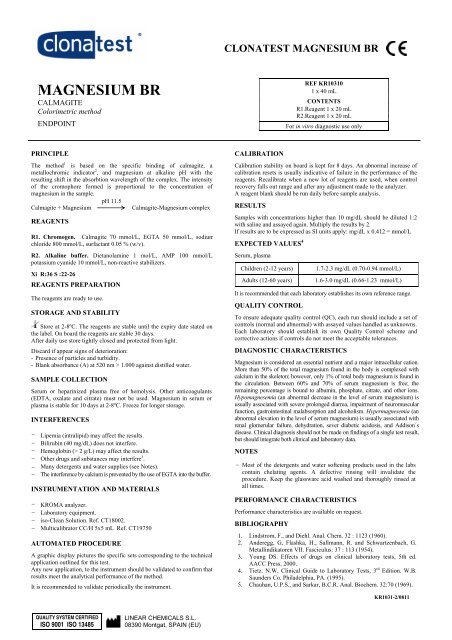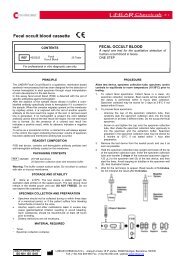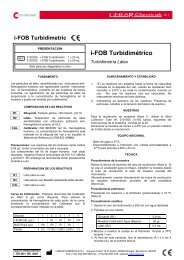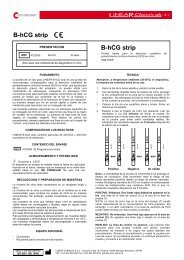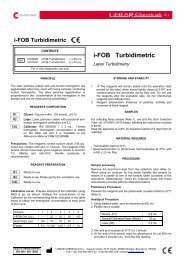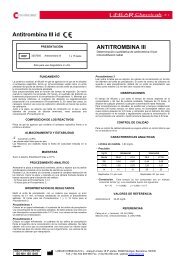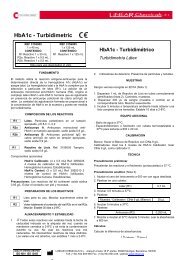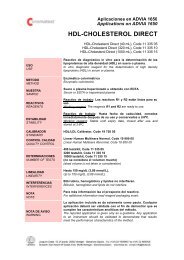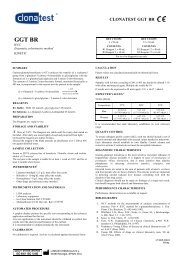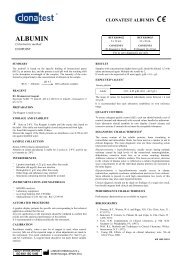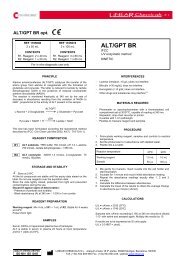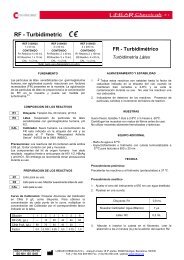You also want an ePaper? Increase the reach of your titles
YUMPU automatically turns print PDFs into web optimized ePapers that Google loves.
CLONATEST <strong>MAGNESIUM</strong> <strong>BR</strong><br />
<strong>MAGNESIUM</strong> <strong>BR</strong><br />
CALMAGITE<br />
Colorimetric method<br />
ENDPOINT<br />
REF KR10310<br />
1 x 40 mL<br />
CONTENTS<br />
R1.Reagent 1 x 20 mL<br />
R2.Reagent 1 x 20 mL<br />
For in vitro diagnostic use only<br />
PRINCIPLE<br />
The method 1 is based on the specific binding of calmagite, a<br />
metallochromic indicator 2 , and magnesium at alkaline pH with the<br />
resulting shift in the absorbtion wavelength of the complex. The intensity<br />
of the cromophore formed is proportional to the concentration of<br />
magnesium in the sample.<br />
pH 11.5<br />
Calmagite + Magnesium<br />
Calmagite-Magnesium complex<br />
REAGENTS<br />
R1. Chromogen. Calmagite 70 mmol/L, EGTA 50 mmol/L, sodium<br />
chloride 800 mmol/L, surfactant 0.05 % (w/v).<br />
R2. Alkaline buffer. Dietanolamine 1 mol/L, AMP 100 mmol/L,<br />
potassium cyanide 10 mmol/L, non-reactive stabilizers.<br />
Xi R:36 S :22-26<br />
REAGENTS PREPARATION<br />
The reagents are ready to use.<br />
STORAGE AND STABILITY<br />
Store at 2-8ºC. The reagents are stable until the expiry date stated on<br />
the label. On board the reagents are stable 30 days.<br />
After daily use store tightly closed and protected from light.<br />
Discard if appear signs of deterioration:<br />
- Presence of particles and turbidity.<br />
- Blank absorbance (A) at 520 nm > 1.000 against distilled water.<br />
SAMPLE COLLECTION<br />
Serum or heparinized plasma free of hemolysis. Other anticoagulants<br />
(EDTA, oxalate and citrate) must not be used. Magnesium in serum or<br />
plasma is stable for 10 days at 2-8ºC. Freeze for longer storage.<br />
INTERFERENCES<br />
−<br />
−<br />
−<br />
−<br />
−<br />
−<br />
Lipemia (intralipid) may affect the results.<br />
Bilirubin (40 mg/dL) does not interfere.<br />
Hemoglobin (> 2 g/L) may affect the results.<br />
Other drugs and substances may interfere 3 .<br />
Many detergents and water supplies (see Notes).<br />
The interference by calcium is prevented by the use of EGTA into the buffer.<br />
INSTRUMENTATION AND MATERIALS<br />
−<br />
−<br />
−<br />
−<br />
KROMA analyzer.<br />
Laboratory equipment.<br />
iso-Clean Solution. Ref. CT18002.<br />
Multicalibrator CC/H 5x5 mL Ref. CT19750<br />
AUTOMATED PROCEDURE<br />
A graphic display pictures the specific sets corresponding to the technical<br />
application outlined for this test.<br />
Any new application, to the instrument should be validated to confirm that<br />
results meet the analytical performance of the method.<br />
It is recommended to validate periodically the instrument.<br />
CALI<strong>BR</strong>ATION<br />
Calibration stability on board is kept for 8 days. An abnormal increase of<br />
calibration resets is usually indicative of failure in the performance of the<br />
reagents. Recalibrate when a new lot of reagents are used, when control<br />
recovery falls out range and after any adjustment made to the analyzer.<br />
A reagent blank should be run daily before sample analysis.<br />
RESULTS<br />
Samples with concentrations higher than 10 mg/dL should be diluted 1:2<br />
with saline and assayed again. Multiply the results by 2.<br />
If results are to be expressed as SI units apply: mg/dL x 0.412 = mmol/L<br />
EXPECTED VALUES 4<br />
Serum, plasma<br />
Children (2-12 years)<br />
Adults (12-60 years)<br />
1.7-2.3 mg/dL (0.70-0.94 mmol/L)<br />
1.6-3.0 mg/dL (0.66-1.23 mmol/L)<br />
It is recommended that each laboratory establishes its own reference range.<br />
QUALITY CONTROL<br />
To ensure adequate quality control (QC), each run should include a set of<br />
controls (normal and abnormal) with assayed values handled as unknowns.<br />
Each laboratory should establish its own Quality Control scheme and<br />
corrective actions if controls do not meet the acceptable tolerances.<br />
DIAGNOSTIC CHARACTERISTICS<br />
Magnesium is considered an essential nutrient and a major intracellular cation.<br />
More than 50% of the total magnesium found in the body is complexed with<br />
calcium in the skeleton; however, only 1% of total body magnesium is found in<br />
the circulation. Between 60% and 70% of serum magnesium is free; the<br />
remaining percentage is bound to albumin, phosphate, citrate, and other ions.<br />
Hypomagnesemia (an abnormal decrease in the level of serum magnesium) is<br />
usually associated with severe prolonged diarrea, impairment of neuromuscular<br />
function, gastrointestinal malabsorption and alcoholism. Hypermagnesemia (an<br />
abnormal elevation in the level of serum magnesium) is usually associated with<br />
renal glomerular failure, dehydration, sever diabetic acidosis, and Addison´s<br />
disease. Clinical diagnosis should not be made on findings of a single test result,<br />
but should integrate both clinical and laboratory data.<br />
NOTES<br />
− Most of the detergents and water softening products used in the labs<br />
contain chelating agents. A defective rinsing will invalidate the<br />
procedure. Keep the glassware acid washed and thoroughly rinsed at<br />
all times.<br />
PERFORMANCE CHARACTERISTICS<br />
Performance characteristics are available on request.<br />
BIBLIOGRAPHY<br />
1.<br />
2.<br />
3.<br />
4.<br />
5.<br />
Lindstrom, F., and Diehl. Anal. Chem. 32 : 1123 (1960).<br />
Anderegg, G, Flashka, H., Sallmann, R. and Schwartzenbach, G.<br />
Metallindikatoren VII. Fasciculus: 37 : 113 (1954).<br />
Young DS. Effects of drugs on clinical laboratory tests, 5th ed.<br />
AACC Press, 2000.<br />
Tietz. N.W. Clinical Guide to Laboratory Tests, 3 rd Edition. W.B.<br />
Saunders Co. Philadelphia, PA. (1995).<br />
Chauhan, U.P.S., and Sarkar, B.C.R. Anal. Biochem. 32:70 (1969).<br />
KR1031-2/0811<br />
QUALITY SYSTEM CERTIFIED<br />
ISO 9001 ISO 13485<br />
<strong>LINEAR</strong> <strong>CHEMICALS</strong> S.L.<br />
08390 Montgat, SPAIN (EU)
CLONATEST <strong>MAGNESIUM</strong> <strong>BR</strong><br />
MAGNESIO <strong>BR</strong><br />
CALMAGITA<br />
Método colorimétrico<br />
PUNTO FINAL<br />
REF KR10310<br />
1 x 40 mL<br />
CONTENIDO<br />
R1.Reactivo 1 x 20 mL<br />
R2.Reactivo 1 x 20 mL<br />
Sólo para uso diagnóstico in vitro<br />
FUNDAMENTO<br />
El método 1 está basado en la unión específica de la calmagita, un<br />
indicador metalocrómico 2 , con el magnesio a un pH alcalino con el<br />
consiguiente desplazamiento del espectro de absorción del complejo. La<br />
intensidad del cromóforo formado es proporcional a la concentración del<br />
magnesio presente en la muestra.<br />
pH 11,5<br />
Calmagita + Magnesio<br />
Complejo Calmagita-Magnesio<br />
REACTIVOS<br />
R1. Cromógeno. Calmagita 70 mmol/L, EGTA 50 mmol/L, sodio<br />
cloruro 800 mmol/L, tensioactivos 0,05%.<br />
R2. Tampón alcalino. Dietanolamina 1 mol/L, AMP 100 mmol/L,<br />
potasio cianuro 10 mmol/L, estabilizantes no-reactivos.<br />
Xi R:36 S :22-26<br />
PREPARACION DE LOS REACTIVOS<br />
Los reactivos están listos para su uso.<br />
ALMACENAMIENTO Y ESTABILIDAD<br />
Conservar a 2-8ºC. Los reactivos son estables hasta la fecha de<br />
caducidad indicada en la etiqueta. En el analizador es estable 30 días. Tras<br />
su uso diario, mantener los reactivos cerrados y protegidos de la luz.<br />
Descartar si se observan signos de deterioro:<br />
- Presencia de partículas y turbidez.<br />
- Absorbancia del Blanco (A) a 520 > 1.000 frente agua destilada.<br />
MUESTRAS<br />
Suero o plasma heparinizado libre de hemólisis.<br />
No usar otros anticoagulantes (EDTA, oxalato y citrato).<br />
El magnesio sérico o plasmático es estable 10 días 2-8ºC. Congelar para<br />
una conservación más prolongada.<br />
INTERFERENCIAS<br />
−<br />
−<br />
−<br />
−<br />
−<br />
−<br />
Lipemia (intralipid) puede afectar los resultados.<br />
Bilirrubina (40 mg/dL) no interfiere.<br />
Hemoglobina (> 2 g/L) puede afectar los resultados.<br />
Otros medicamentos y sustancias pueden interferir 3 .<br />
Detergentes y suministros de agua de laboratorio (ver Notas).<br />
La interferencia del calcio se evita adicionando EGTA en el reactivo.<br />
EQUIPO ADICIONAL<br />
−<br />
−<br />
−<br />
−<br />
Analizador KROMA.<br />
Material de laboratorio.<br />
iso-Clean Solution. Ref. CT18002.<br />
Multicalibrator CC/H 5x5 mL Ref. CT19750<br />
TECNICA AUTOMATICA<br />
Una representación grafica visualiza los ajustes específicos<br />
correspondientes a la aplicación técnica diseñada para este ensayo.<br />
Cualquier aplicación nueva al instrumento deberá validarse para<br />
confirmar que los resultados cumplen las características del método.<br />
Se recomienda validar periódicamente el instrumento.<br />
CALI<strong>BR</strong>ACION<br />
La estabilidad de calibración con los reactivos dispuestos en abierto es de 8<br />
días. Un aumento anormal en la frecuencia de calibración esta generalmente<br />
asociada a un fallo de funcionalidad de los reactivos.<br />
Recalibrar al emplear un lote nuevo de reactivos, cuando los valores control<br />
se hallan fuera de rango y tras cualquier ajuste realizado en el instrumento.<br />
Realizar un blanco diariamente antes de analizar las muestras.<br />
CALCULOS<br />
Muestras con concentraciones de magnesio superiores a 10 mg/dL se diluyen<br />
1:2 con solución salina y repetir el ensayo. Multiplicar los resultados por 2.<br />
Para expresar los resultados en unidades SI aplicar: mg/dL x 0,412 = mmol/L<br />
VALORES DE REFERENCIA 4<br />
Suero, plasma<br />
Niños (2-12 años)<br />
Adultos (12-60 años)<br />
1,7-2,3 mg/dL (0,70-0,94 mmol/L)<br />
1,6-3,0 mg/dL (0,66-1,23 mmol/L)<br />
Se recomienda que cada laboratorio establezca su propio rango de referencia.<br />
CONTROL DE CALIDAD<br />
Para un control de calidad (CC) adecuado, se incluirán en cada serie controles<br />
valorados (normal y abnormal) que se tratarán como muestras problema.<br />
Cada laboratorio debe establecer su propio Control de Calidad y sus medidas<br />
correctoras cuando los controles no cumplan con las tolerancias exigidas.<br />
SIGNIFICADO CLINICO<br />
El magnesio está considerado como un nutriente esencial y un catión<br />
intracelular de primer orden. Más del 50% del magnesio total forma parte<br />
junto con el calcio de la sustancia mineral ósea y sólo el 1% del magnesio<br />
total corporal se halla en la circulación. Entre el 60% y el 70% del magnesio<br />
en el plasma se encuentra en forma libre mientras que el porcentaje restante<br />
permanece unido a la albúmina, fosfato, citrato, y otros iones. La<br />
hipomagnesemia (bajo nivel de magnesio en el suero) está generalmente<br />
asociada a una alteración neuromuscular, prolongadas diarreas, síndrome de<br />
malabsorción intestinal y alcoholismo.<br />
La hipermagnesemia (elevado nivel de magnesio en el suero) está asociada<br />
con el fallo glomerular renal, deshidratación, acidosis diabética severa y<br />
enfermedad de Addison. El diagnóstico clínico no debe realizarse con los<br />
resultados de un único ensayo sin atender los datos clínicos del paciente.<br />
NOTAS<br />
−<br />
La mayoría de detergentes y productos de tratamiento de aguas<br />
empleados en los laboratorios contienen agentes quelantes. Un<br />
enjuague defectuoso invalida el procedimiento. Mantener en todo<br />
momento el material de vidrio lavado al ácido y enjuagado a fondo.<br />
CARACTERISTICAS ANALITICAS<br />
Las características analíticas están disponibles bajo solicitud.<br />
REFERENCIAS<br />
1.<br />
2.<br />
3.<br />
4.<br />
5.<br />
Lindstrom, F., y Diehl. Anal. Chem. 32 : 1123 (1960).<br />
Anderegg, G, Flashka, H., Sallmann, R. y Schwartzenbach, G.<br />
Metallindikatoren VII. Fasciculus: 37 : 113 (1954).<br />
Young DS. Effects of drugs on clinical laboratory tests, 5th ed.<br />
AACC Press, 2000.<br />
Tietz. N.W. Clinical Guide to Laboratory Tests, 3 rd Edition. W.B.<br />
Saunders Co. Philadelphia, PA. (1995).<br />
Chauhan, U.P.S., y Sarkar, B.C.R. Anal. Biochem. 32:70 (1969).<br />
QUALITY SYSTEM CERTIFIED<br />
ISO 9001 ISO 13485<br />
<strong>LINEAR</strong> <strong>CHEMICALS</strong> S.L.<br />
08390 Montgat, SPAIN (EU)
Aplicaciones en KROMA<br />
Applications on KROMA<br />
<strong>MAGNESIUM</strong> <strong>BR</strong><br />
Two reagents method<br />
Magnesium <strong>BR</strong> (1 x 40 mL), Code KR10310<br />
USO<br />
USE<br />
METODO<br />
METHOD<br />
MUESTRA<br />
SAMPLE<br />
REACTIVOS<br />
REAGENTS<br />
CALI<strong>BR</strong>ADOR<br />
STANDARD<br />
CONTROL CALIDAD<br />
QUALITY CONTROL<br />
DETERMINACIONES<br />
NUMBER OF TESTS<br />
LINEALIDAD<br />
<strong>LINEAR</strong>ITY<br />
NOTA<br />
NOTE<br />
NOTA DE AVISO<br />
WARNING<br />
Reactivo de diagnóstico in vitro para la determinación de<br />
magnesio en suero o plasma.<br />
In vitro diagnostic reagent for the determination of magnesium in<br />
serum or plasma.<br />
Colorimétrico<br />
Colorimetric<br />
Suero o plasma heparinizado libre de hemólisis<br />
Serum or heparinized plasma free of hemolysis<br />
Los reactivos R1 y R2 están listos para su uso.<br />
The reagents R1 and R2 are ready to use.<br />
Linear Multicalibrator CC/H, Code CT19750<br />
Linear Human Multisera Normal CT19800<br />
Linear Human Multisera Abnormal CT19850<br />
133 tests/kit, Code KR10310<br />
(no se considera el volumen muerto)<br />
(dead volume is not taken in consideration)<br />
Sin post-dilución automática: Hasta 10 mg/dL<br />
Without automatic post-dilution: Up to 10 mg/dL<br />
Para más información lea el prospecto del reactivo.<br />
For additional information read reagent packaging insert.<br />
La aplicación incluida se da solamente como pauta. Cualquier<br />
aplicación deberá ser validada con el fin de demostrar que se<br />
cumplen las características analíticas del método.<br />
The reported application is given only as a guideline. Any application<br />
to an instrument should be validated to demonstrate that results meet<br />
the performance characteristics of the method.<br />
QUALITY SYSTEM CERTIFIED<br />
ISO 9001 ISO 13485<br />
<strong>LINEAR</strong> <strong>CHEMICALS</strong> S.L.<br />
08390 Montgat, SPAIN (EU)
KROMA<br />
<strong>MAGNESIUM</strong> <strong>BR</strong><br />
Name N. of Standards N. of rep. Units Stability<br />
Magnesium <strong>BR</strong> 2 1 mg/dL<br />
*<br />
* entered by the user KR10310-1/0907<br />
QUALITY SYSTEM CERTIFIED<br />
ISO 9001 ISO 13485<br />
<strong>LINEAR</strong> <strong>CHEMICALS</strong> S.L.<br />
08390 Montgat, SPAIN (EU)


